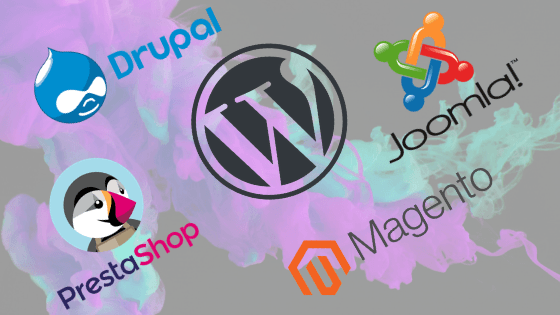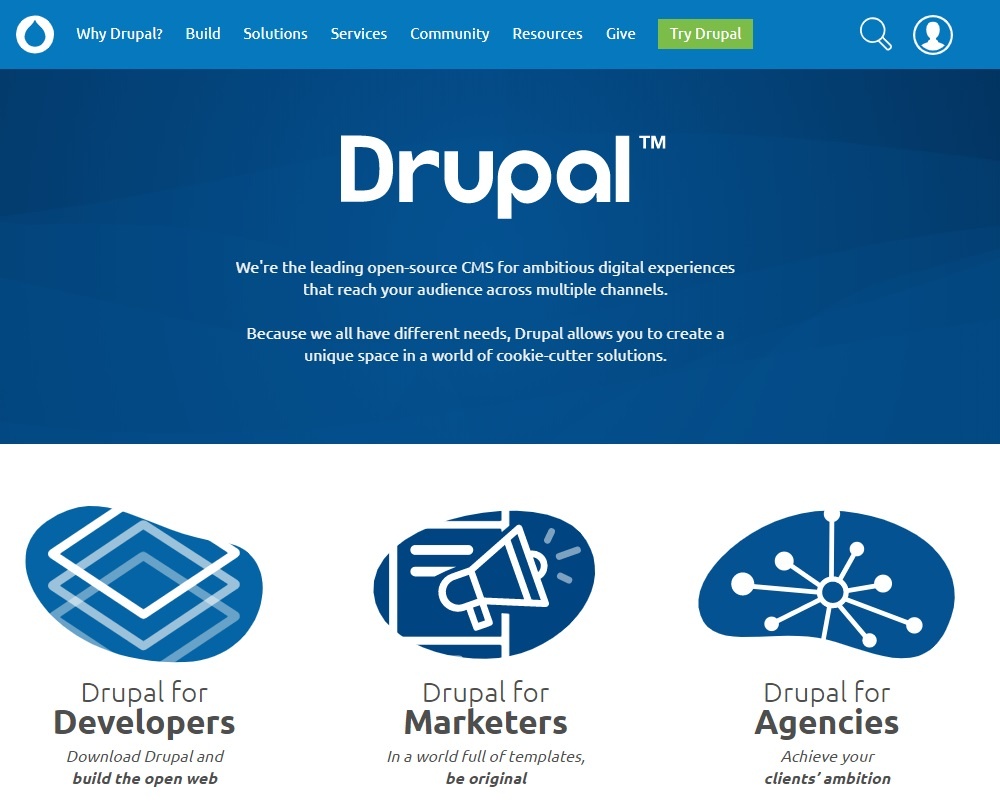Do you know what is CMS or have you heard about it? If you deal with websites directly, you have probably heard of them. But, you may not understand it yet. Therefore, our goal with this article is that you understand what a CMS is and its particulars. We will explain what a CMS is, what it is for, and how it works, the most popular today and the advantages and disadvantages of using it. Then we will look at the following topics:
Table of Contents
What is CMS?
The acronym CMS stands for Content Management System. That is, it is a system designed to manage the information contained in a website. It can be responsible for only one or more parts, or the entire page.
From this, the creation, editing, publishing, and distribution of information becomes easier and more practical.
The main goal of a CMS is to make changes to a website done quickly, intuitively, and without the need for coding expertise. That is, anyone who has access to this CMS can make the necessary modifications. Even if this person has no knowledge of any computer language.
For ease of understanding, let’s say a website has a photo gallery. However, the customer wishes to be able to add new photos in the future through a single system. Therefore, the developer can create his own CMS for this function. This way, the customer will have what they want and will be able to add new photos through this system. Still, as an example, we can think of blogs, which usually receive the addition of new posts. Therefore, a CMS is the best option for those who want to have a blog.
There are several types of CMS. From CMS created individually for each client, even CMS already developed thinking in one or more specific niches. We may have systems that take care of only one section of the website. However, we may also have more robust systems that can accomplish all the creation of a website.
There are currently some open source CMS that stand out around the world. They allow you to create a complete website even without the knowledge of computer languages. Among the most popular are WordPress, Joomla, and Drupal. We also find Magento and PrestaShop, which are focused on e-commerce.
How does a CMS work?
As explained earlier, there are CMS that can perform simple functions and others that can perform more complex functions. Thus, some CMS are now able to create even more complex systems, such as e-commerce systems.
To understand how a CMS works, you need to understand a little about how a webpage works. Basically, all the visual parts you find on the page are rendered by the browser through HTML, CSS and JavaScript code. This is what we call Front End Development.
However, through other languages in conjunction with databases, you can make these pages dynamic. That is, you can create code that generates HTML from the server. That way, in the end, the browser will render the HTML normally. That is, through the programming language, we can modify the HTML code. In addition, we can also create systems and everything that involves the server. So this part behind the page is what we call Back End Development. It is the part of the site that runs on the server and is not necessarily visible to visitors.
PHP is a programming language commonly used in CMS creation. As it relates very well to HTML.
Understanding this makes it easy to see how CMS works. Basically, it is a Back End system that will perform one or more functions. These functions can modify the final rendering of the page. These systems usually come with a dashboard, which can be accessed through the browser. In this dashboard, you will have access to everything CMS is capable of.
Of course, each CMS has its peculiarities and functions. But in short, what is described above is the format in which CMS works on the server to generate content that will be rendered in the visitor’s browser.
Example:
Imagine a blog that should receive content daily.
To do this manually, you would need to create a new page for each new publication. Therefore, it will take a long time to develop each one. Also, you would probably still need to change the other pages to “update” with this new post. Yet another problem: You must have the technical knowledge of the computer languages involved.
Already with a CMS, we do it all quickly, simply and dynamically. In addition, the general technical knowledge of languages is not required.
Therefore, CMS is the ideal solution for everyone who needs a website that is not 100% static.
What are the functions of a CMS?
Generally speaking, a CMS has the essence of making information creation, editing, publishing, and distribution easier and more practical. Therefore, its main function is to facilitate the management of part of a website or the entire website. In other words, the great advantage of CMS is that it can manage dynamic content simply.
Each CMS is designed for a customer or niche with different needs. So there is no way to define a specific function for all these systems. Therefore, when creating a CMS, the developer must think about the functions the customer needs. Similarly, when choosing a CMS, the user must verify that it has the functions that meet its needs.
On top of all this, some open-source CMS are widely used and constantly updated. Nowadays, with tools like WordPress, Joomla or Drupal, you can create a website completely from scratch without even knowing any computer code. Thanks to the number of plugins, themes, and extensions they have, even more advanced systems can be built through CMS itself. For example, complete e-commerce systems.
Some functions present in most modern CMS
As explained earlier, CMS can have several functions. It will be up to the developer to create these functions with their goals in mind.
Therefore, for a single page, the developer may create a small content management system that can perform one or more simple and specific functions.
But when it comes to more complete CMS like WordPress, Joomla and Drupal, there are numerous functions. Among them, there are some functions present in most of these CMS:
- Creation and publication of content and pages;
- editing of texts and site codes;
- media library, where we store used images and videos on the site;
- installation of extra features, such as plugins and extensions, that increase the functionality of the website;
- moderation of comments;
- multiple user support;
- content flow control;
- applications of simplified SEO techniques;
- simplified visual changes;
- automatic Responsive Design;
- hierarchically organized content;
- Dashboard is easily accessible from anywhere without the need for specific software.
Most popular CMS
Although there are many CMSs around the world, some stand out more than others. Therefore, they end up being the most recommended. One of the biggest examples of this is WordPress, which accounts for 34% of websites available on the web.
While many debates this, there is no specific CMS that is better than everyone else. Each CMS has its own peculiarities. Therefore, it is up to the user to choose the CMS that best suits their needs.
However, a good tool should always be user-friendly, flexible and secure. Therefore, these 3 characteristics are common in all outstanding CMS. To help, let’s present a little about five of the most popular:
- WordPress
- Joomla
- Drupal
- Magento
- PrestaShop
Note that the first 3 have a broader focus, while the last two have as their main focus the e-commerce.
WordPress
WordPress is the most widely used CMS in the world. About 34% of webpages use this CMS. Its emphasis is on accessibility, performance, safety, and ease of use. WordPress is a system designed for everyone.
WordPress is an open-source system. Through the PHP programming language, developers were able to create their entire structure. It is also through PHP that we can create new plugins, themes, extensions, and other system modifications. In addition, WordPress has one of the largest communities in the world. So it is common for you to find several new plugins, themes, and extensions. Also, it is common for him to always be up to date. With these extra features, you can extend WordPress functionality so that it can perform more functions.
It was founded by Matt Mullenweg in 2003. Initially, its platform was developed with a focus on blogs. However, WordPress is currently used for virtually all types of websites. From institutional websites, corporate websites, blogs to large portals and e-commerce systems.
CopaHost has all the hosting infrastructure for WordPress, with optimized and robust plans. A good WordPress hosting plan needs to have an SSD storage infrastructure, and a properly configured and always up-to-date firewall. This is because WordPress releases security updates almost daily. With the experience of CopaHost technical analysts, we know all the points to be optimized in terms of safety. Thus we offer you the best in terms of WordPress Hosting.
You can read or watch more about installing WordPress in our articles.
NOTE: It is important to note that we are referring to WordPress.org, not WordPress.com.
Joomla
Founded in 2005, Joomla is one of the most widely used CMS sites. Joomla was created based on PHP and is open source. But its structure allows the creation of advanced applications.
Although not the most famous, Joomla is one of the most robust and reliable CMS alternatives. It also has a community of developers and volunteers who ensure that Joomla is always growing and improving its functions. They ensure the platform is user-friendly, extensible, multilingual, accessible, responsive and SEO-optimized.
Between Joomla, WordPress, and Drupal, we can say that Joomla is the middle ground between the complexity of Drupal and the simplicity of WordPress.
Its robust system allows it to be used for the creation of all types of websites. Therefore, the user can create from personal websites to e-commerce systems.
Drupal
Drupal is a CMS aimed entirely at customization and extensibility. It is also an open-source platform. It has several native features that facilitate content creation and management.
Drupal stands out from other CMSs because of two features: page load time and its advanced security system. But compared to WordPress and Joomla, it is harder to learn.
It was created in 2001 by Dries Buytaert. Your system requires a little more technical knowledge to install, make edits and make updates. That is, you need to know a little more about the tool in order to take advantage of its functions.
The platform works in modules that interact with each other, allowing for greater system customization. This allows the user to add any type of resources they want.
In the corporate universe, he is one of the most adopted and recommended CMS. Companies like NASA, Tesla, Sony, and even the United States Government use Drupal as their content platform.
However, despite being a more robust system, Drupal meets the needs of all types of users. Therefore, the user can use to create blogs, institutional pages, portals or even more complex applications such as e-commerce and analytics systems, marketing systems, etc.
Magento
Focused on e-commerce, Magento is a platform that has become very popular. Big companies like Samsung, Ford, and Nike use Magento as their platform.
With Magento, you can create a complex web store with many features, including more advanced features. As it is a very complete platform, it takes a longer time to know its main functions.
With this CMS, the user can create product sales and delivery pages, such as landing pages. It can also manage stocks, orders, shipping methods, payments, among others. Finally, it also allows the user to run marketing campaigns and add professional coupons. That is, with Magento, you have everything you need to create a full-featured, professional web store you may need.
Unlike the first 3 CMS presented, Magento is a specific CMS for the creation of online stores and e-commerce.
You can read about “How to Install Magento using cPanel” as well as “Magento tutorial: initial configuration” on our blog.
PrestaShop
Focused on e-commerce, PrestaShop is a CMS that has stood out since its inception. Today, more than 270,000 online stores worldwide are using this CMS.
It brings a great solution for small and medium businesses. Through it you can quickly create a store, you can customize the layout simply, you can even upload products, and you can perform other configurations. In addition, it offers configurations and customization of online stores that are starting now.
Anyway, it’s a great system for online stores, bringing great features and has a lot to offer. Like Magento, PrestaShop is also a CMS specific for e-commerce and e-commerce creation.
You can read about How To Install Prestashop on our blog.
Advantages and Disadvantages of Adopting a CMS for Your Website
With all the information up to this topic, you already know what a CMS is, as well as the main functions found among most modern CMS. However, despite bringing a wide variety of good features, there are also disadvantages to their use. Let’s cite below the main advantages as well as the main disadvantages of using CMS.
Advantages
- Ease of creation and maintenance;
- Ease of use in general, such as updating and editing articles, images, banners, etc;
- No knowledge of computer languages is required to use a CMS;
- Allow us to install additional features like plugins, themes, and extensions;
- They have a great diversity of ready-made themes, both free and paid;
- Constant updates;
- Most popular CMS has a large community, which facilitates learning;
- Usually, CMS contains well-updated documentations, as well as tutorials and videos;
- SEO possibility made easy;
- Versatility for projects of all types and sizes;
- Low cost of upgrade and maintenance;
- Most CMS are open source. Therefore, you only need to pay for the domain and hosting.
Disadvantages
- If you need any specific functionality that has no plugin, you will probably need a professional developer to implement it;
- The loading time for a page made with pure programming is longer than for sites made with CMS. However, some extensions and plugins can be used to alleviate this problem;
- The finished themes are often very generic. Which ends up being possible to find several websites with a similar style. Therefore, your site loses some of the authenticity and personality of the page;
- The more popular a CMS becomes the more malicious attacks on it. Criminals may find breaches in the CMS system and can damage your entire project. However, with some plugins and extensions, you can significantly reduce security risks.
Should I adopt a CMS to create my site? And which one to choose?
First of all, you must understand your needs. Depending on what you need, a static page can be much more beneficial. It is still possible that a page created entirely by a web developer through code may be more beneficial because it can fit your needs exactly. In addition, you can hire a professional who creates their own CMS for certain functions without necessarily using the most popular CMS. Of course, this has a higher cost.
However, if you plan to set up an online store, move a lot of content such as a blog, create a portal or make constant changes to the site, the best option is to adopt a CMS as one of those listed above.
Here are some tips to choose from among the CMS mentioned above. Analyze the type of site you need:
- If you want to make a blog or small business website, we recommend choosing between WordPress or Joomla.
- For a rapidly scaling corporate site, consider using Drupal, even though it’s a bit more complex.
- If you would like to make an eCommerce store, we recommend you can choose Magento or PrestaShop.
Conclusion
As you read this article, you can now take a closer look at what you want, such as plugins, extensions, and more. Plus, you already know the top CMSs on the market and you can choose which one to use. Even professional web designers must have good knowledge in CMS systems. Finally, when using a CMS, you have everything you need to build your website and mark your presence and positioning on the internet. Hurry up and get your website online now!
But don’t forget that to do this, you need to hire a Web Hosting service through a Provider, as well as have a registered domain name.
But there is no need to worry: At CopaHost you will find several hosting plans to choose the one that best suits your needs. And better: All our plans are optimized for WordPress usage!
To be the best website hosting, CopaHost combines a fair price with qualified service! Therefore, there is no doubt that you will be very pleased with our services. Enjoy the moment and know our plans!





